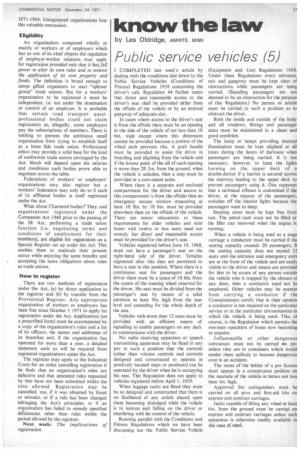know the law
Page 33

If you've noticed an error in this article please click here to report it so we can fix it.
by Les Oldridge, AMIRTE, MIMI
Public service vehicles ,(5)
I COMPLETED last week's article by dealing with the conditions laid down by the Public Service Vehicles (Conditions of Fitness) Regulations 1958 concerning the driver's cab. Regulation 44 further states that direct and reasonable access to the driver's seat shall be provided either from the offside of the vehicle or by an internal gangway of adequate size.
In cases where access to the driver's seat is from the offside there must be an opening in the side of the vehicle of not less than 1ft 6in. wi.cle except where this dimension cannot be provided because a portion of the wheel arch prevents this. A grab handle must be provided to assist the driver in boarding and alighting from the vehicle and if the lowest point of the sill of such opening is more than 2ft 3in. from the ground, when the vehicle is unladen, then a step must be provided at a convenient point.
Where there is a separate and enclosed compartment for the driver and access to this compartment is from the offside then an emergency escape window measuring at least 1ft 9in. by lit 6in. must be provided elsewhere than on the offside of the vehicle. There are minor relaxations to these requirements for older vehicles and mini buses with twelve or less seats need not comply but direct and reasonable access must be provided for the driver's seat.
Vehicles registered before June 19, 1968, must not have a passenger's seat on the right-hand side of the driver. Vehicles registered after this date are permitted to have a seat in this position. Where there is a continuous seat for passengers and the driver there must be a space of 1ft 6in. from the centre of the steering wheel reserved for the driver. His seat must be divided from the passenger's seat by means of a solid partition at least 9in. high from the seat level and extending for the whole depth of the seat.
Vehicles with more than 12 seats must be provided with an efficient means of signalling to enable passengers on any deck to communicate with the driver.
No radio receiving apparatus or speech transmitting apparatus may be fitted in any psv in such a position that the controls (other than volume controls and controls designed and constructed to operate in positively located steps or positions) can be operated by the driver when he is occupying his seat. This Regulation does not apply to vehicles registered before April I, 1959.
When luggage racks are fitted they must be so designed and constructed that there is no likelihood of any article placed upon them becoming dislodged while the vehicle is in motion and falling on the driver or interfering with his control of the vehicle.
Running parallel with the Conditions and Fitness Regulations which we have been discussing 'are the Public Service Vehicle (Equipment and Use) Regulations 1958. Under these Regulations every entrance, exit and gangway must be kept clear of obstructions while passengers are being carried. (Standing passengers are not deemed to be an obstruction for the purpose of this Regulation.) No person or article must be carried in such a position as to obstruct the driver.
Both the inside and outside of the body and all windows, fittings and passenger seats must be maintained in a clean and good condition.
The lamp or lamps providing internal illumination must be kept alighted at all times during the hours of darkness when passengers are being carried. It is not necessary, however, to keep the lights burning on the upper deck of a double-decker if a barrier is secured across the stairway leading to the upper deck to prevent passengers using it. One supposes that a technical offence is committed if the driver, at the request of the passengers, switches off the interior lights because the passengers want to sleep.
Steering arms must be kept free from rust. The petrol tank must not be filled or the filler cap removed when the engine is running.
When a vehicle is being used as a stage carriage a conductor must be carried if the seating capacity exceeds 20 passengers. II the seating capacity does not exceed 32 seats and the entrance and emergency exits are at the front of the vehicle and are easily visible to the driver and means are provided for him to be aware of any person outside the vehicle who is trapped by the closure of any door, then a conductor need not be employed. Other vehicles may be exempt from carrying a conductor if the Commissioners certify that in their opinion a conductor is not required on the particular service or in the particular circumstances in which the vehicle is being used. This, of course, is the Regulation which permits the one-man operation of buses now becoming so popular.
Inflammable or other dangerous substances must not be carried on psv unless they are in containers which would render them unlikely to become dangerous even in an accident.
The name of the holder of a psv licence must appear in a conspicuous position on the nearside of the vehicle in letters not less than lin. high.
Approved fire extinguishers must be carried on all psys and first-aid kits on express and contract carriages.
Jacks capable of lifting any wheel at least 6in. from the ground must be carrie.d on express and contract carriages unless such apparatus is otherwise readily available in the case of need.




































































